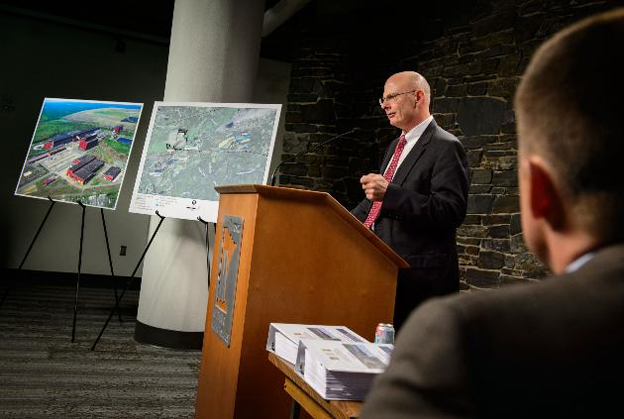
Lee Schafer looks at PolyMet
Notices a hole, and it isn’t the mine
Lee Schafer, a business writer at the Star Tribune, wrote a column on Sunday, December 8th about the recently issued supplemental environmental impact statement by PolyMet Mining. Here’s the lede:
Mark Twain’s explanation that “a mine is just a hole in the ground with a liar standing next to it” is a quote so brilliant and so often repeated that it’s a shame he may never have said it.
You know, somehow, on reading the lede, that the column isn’t going to be pro-PolyMet.
Schafer goes on to describe the hole:
Mining for copper and nickel typically requires monitoring and cleaning of water. The draft environmental report said there could be a need to monitor and treat the water for a minimum of 200 years at the site where PolyMet plans to be digging and a minimum of 500 years at the nearby processing plant site.
At the risk of stating the obvious, 500 years is a very long time. It was 500 years ago when the Italian diplomat Niccolò Machiavelli sat down and wrote a little how-to book for political leaders called “The Prince.” [I wrote that we’d barely begun stealing the place from the Indians 500 years ago, but why quibble?]
The task of providing financial assurance begins with estimating what it will cost to shut down operations, contain the waste, monitor the water quality and treat the water that becomes polluted. With that cost estimate in hand, the mine operator then arranges for enough money to be available, such as through a trust account, to pay for all the costs more or less forever.
The big environmental report just released, called the supplemental draft environmental impact statement, has just a small section on financial assurance that says next to nothing.
Whistling past the PolyMet graveyard, so to speak.
Perhaps it’s just as well, given PolyMet’s propensity to, um, dissemble.
A promise from PolyMet is irrelevant, anyway
Why? Let’s be direct. PolyMet doesn’t have a pot to piss in. But don’t believe me; believe PolyMet itself. From its most recent annual filing with the Securities and Exchange Commission:
We will need to seek additional financing to complete our development and construction of the NorthMet Project. Sources of such external financing include future equity and debt offerings, advance payments by potential customers to secure long-term supply contracts, grants and low-cost debt from certain state financial institutions, and commercial debt secured by the NorthMet Project. If we cannot raise the money necessary to continue to explore and develop our property, we will have to suspend or cease operations.
That’s a quote from page seven. It would be nice if the candor (or candour for you Canucks), offered to investors would be afforded to regulators and Minnesota citizens and taxpayers, too.
But I suppose saying, Gosh, we don’t have the money to open or operate the mine, let alone close it down and treat the toxic water, would be, well, kind of a non-starter, wouldn’t it?
Permitting PolyMet’s mine without a guaranty of environmental responsibilities from Glencore/Xstrata would be utter folly
Who’s Glencore/Xstrata? Funny you should ask. You know, PolyMet itself has been asking the same question. But most of you already know that Glencore/Xstrata is PolyMet’s puppet master.
The corporate structure of PolyMet is what can charitably be called a shell corporation in Minnesota (or maybe a “front”), owned by a publicly-traded Canadian corporation, which in turn has one principal shareholder, which did not acquire its shares of PolyMet on the open market. This shareholder, Glencore/Xstrata, the Swiss mining conglomerate, which owns about a third of PolyMet, is also its secured lender. It also is entitled to buy all of the ore and concentrate from the mine, a so-called “offtake” agreement. The legal, financial and practical control of PolyMet by Glencore/Xstrata is absolute.
If the State of Minnesota was a bank, and the street urchin PolyMet came in for loan, the bankers would say, Come back and talk to us when you’ve got a credit-worthy guarantor, Junior.
In looking at the application of PolyMet to open a sulfide mine in Minnesota, the governor and the DNR ought to do the same thing regarding PolyMet’s environmental responsibilities. Come back and talk to us when you’ve got senior mining company Glencore/Xstrata’s guaranty in your pocket, Junior mining company.
Even then, it’s an iffy proposition. Glencore already has a track record of dodging environmental and labor obligations all over the world. Just for example, Glencore is trying to avoid Super Fund responsibility for an aluminum plant in Montana. Here’s a little from the linked story here at LeftMN last July:
Montana’s Senator John Tester is not the only one who finds Glencore and its new merger partner Xstrata’s labor practices to be odious. How about Canada, South Africa, Argentina, Australia, the Democratic Republic of the Congo, Colombia, Equatorial Guinea, Ivory Coast and Zambia, among others.
According to the linked post:
Recent research published in the journal Foreign Policy shows that Glencore’s fundamental business model relies on operations in weak governance zones where public scrutiny and transparency are frequently absent.
When the mainstream Foreign Policy is on your case, you know you are an outlier.
But we will shortly find out whether Minnesota is one of those “weak governance zones,” won’t we?
With the publication of the supplemental EIS and the upcoming opening of the public comment period, we’re coming close to finding out what kind of “governance zone” we really live in, aren’t we?
Given DNR Commissioner Tom Landwehr’s sputtering explanation of how 500 years really isn’t 500 years on Almanac on Friday, December 6th, your confidence may be waning.
Even genial host Cathy Wurzer said, Gee, it sounds like there is a lot of uncertainty.
You said it, Cathy.
Thanks for your feedback. If we like what you have to say, it may appear in a future post of reader reactions.


